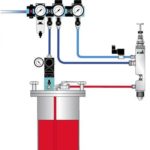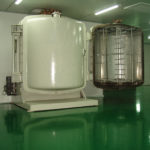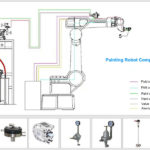Teflon(known as Polytetrafluoroethylene or PTFE) is a polymer formed by the close combination of carbon atoms and fluorine atoms. Because of its excellent chemical stability, high temperature resistance, low coefficient of friction and excellent insulation properties, it is known as the “King of Plastics”
In addition to polytetrafluoroethylene (PTFE), there are other related fluoroplastics, i.e. plastics with fluorine (F)! Including PTFE (polytetrafluoroethylene), ETFE (ethylene-tetrafluoroethylene copolymer), FEP (fluorinated ethylene propylene copolymer), PFA (perfluoroalkylate) and PVDF (polyvinylidene fluoride) are all fluoroplastics, that is, polymer materials containing fluorine atoms, which have their own characteristics in chemical structure, physical properties and applications.
Below is a table list of 5 Teflon materials with its basic characteristics
| Performance/Materials | PTFE(polytetrafluoroethylene) | ETFE(Ethylene-tetrafluoroethylene copolymer) | FEP(Fluorinated ethylene propylene copolymer) | PFA(Perfluoroalkylated substances) | PVDF(Polyvinylidene fluoride) |
| Chemical resistance | A+ | A | A | A+ | A- |
| Temperature resistance | -260~260℃ | -200~150℃ | -200~200℃ | -200~260℃ | -40~150℃ |
| Mechanical properties | Brittle with average toughness | Good toughness and high strength | Good toughness | Good toughness and high strength | High strength and good toughness |
| Processability | Poor, non-melt processable, not suitable for injection molding | Good and weldable | Good, can be extruded and blown by injection molding | Excellent, melt processing (injection molding, extrusion)) | Good, can be extruded, injection molding, solution coating |
| Electrical properties | Excellent | Excellent | Excellent | Excellent | Good |
| Applications | Cookware coating, sealing, wire insulation | Membrane structures, chemical containers, semiconductors | Lining of wires and cables, chemical equipment | Semiconductors, food processing, chemical containers | Water pipes, battery separators, anti-corrosion coatings |
| Key features | It has excellent heat resistance, relatively low mechanical strength, high hardness, and is commonly used for compression molding or paste extrusion | Chemically resistant and at the same time very transparent | Transparent or translucent, easy to weld, suitable for complex shape products | Stable at high temperatures, chemically resistant, superior in strength and abrasion resistance to PTFE | The cost is relatively low, and the weather resistance and UV resistance are excellent, and they are often used in outdoor coatings |
Polytetrafluoroethylene(PTFE)
Polytetrafluoroethylene (PTFE), known as the “king of plastics”, is a crystalline polymer with excellent properties made from the polymerization of tetrafluoroethylene by free radicals. Its high melting point of 327 °C and its high viscosity when melted (1010 Pa·S at 380 °C) make direct forming quite challenging. With densities ranging from 2.13 to 2.19g/cm³, PTFE exhibits excellent chemical stability, a stable dielectric constant of 2.1, a low dissipation factor, and retains its performance over a wide range of temperature and frequency domains.
The mechanical properties of PTFE perform well over a very wide temperature range (-80°C to 260°C), especially the impact strength, although its tensile strength, abrasion resistance and creep resistance are slightly inferior to those of other engineering plastics. For this purpose, these specific mechanical properties can be effectively enhanced by adding modified materials such as fiberglass, bronze, carbon or graphite.
PTFE is particularly known for its ultra-low coefficient of friction, which is much lower than most known materials, and its high oxygen index (OI) of 95%, highlighting its advantages in terms of fire safety. In view of these unique properties, PTFE is widely used in high-end fields such as anti-corrosion, chemical piping systems, heat exchange technology, precision machinery manufacturing, electronic and electrical insulation, medical equipment, and as a high-performance powder raw material, showing its extraordinary application value and adaptability.
Ethylene-tetrafluoroethylene copolymer (ETFE)
ETFE, or ethylene-tetrafluoroethylene copolymer, is known for its excellent comprehensive properties and is a leader in the field of fluoroplastics. On the basis of inheriting the excellent high temperature resistance, chemical resistance and electrical insulation characteristics of PTFE, the material has achieved a significant enhancement of radiation resistance and mechanical properties, showing a tensile strength of up to 50MPa, which is equivalent to twice the strength of PTFE, and the processability has also been revolutionized. In particular, its excellent adhesion to metal surfaces opens up practical possibilities for the tight lining technology of fluoroplastics and steel.
As a model of high-performance materials, ETFE not only has excellent impact resistance, electrical conductivity, thermal stability and corrosion resistance, but also has high strength and excellent processing adaptability, and is widely involved in many high-tech fields such as chemical industry, electronic communications, equipment manufacturing and aerospace.
In addition, ETFE has demonstrated innovative applications in modern architectural design, using membrane structures as raw materials to construct roofs and walls that are lightweight (only 1% weight of the same volume of glass), strong (more than 400% ductile), high tensile and hard-to-tear. The material also exhibits excellent weather resistance, chemical resistance, a high melting point of 200°C, and self-extinguishing, providing a safe and innovative solution for the construction sector.
Polyperfluoroethylene propylene (FEP)
FEP, as a high-grade fluoropolymer, is derived from the copolymerization reaction of tetrafluoroethylene and hexafluoropropylene, which has excellent properties and exhibits a unique combination of properties.With a melting point of 304°C and a density of 2.15g/cm³, it is classified as a flexible plastic, and although it is slightly inferior to some engineering plastics in terms of tensile strength, wear resistance and creep resistance, its chemical inertness is particularly prominent.
One of the highlights of the material is its low dielectric constant (2.1) over a wide frequency spectrum, combined with its non-flammability, with an oxygen index of up to 95%, which is effectively flame retardant and exhibits excellent environmental resistance.FEP has a low coefficient of friction and can be used in a wide temperature range, from cryogenic temperatures up to 392°C.
FEP can be processed into pellets suitable for extrusion or molding, as powders for fluidized bed and electrostatic spraying, or as aqueous dispersions.Its semi-finished forms, such as films, plates, rods and monofilaments, are widely used in high-end applications, such as the construction of anti-corrosion pipes and chemical containers, the enhancement of drum surface properties, and the manufacture of various types of special cables, including aviation hook wires, high voltage cables, alarm system cables, flat cables and oil exploration cables, fully demonstrating the value and status of FEP in high-tech and harsh environment applications.
Fusible polytetrafluoroethylene (PFA)
PFA, short for perfluoroalkoxy fluoroplastic, is a high-performance material in the perfluorinated family with PTFE, which has all the superior properties of PTFE and can be melt processed at relatively low temperatures, which is more than PTFE. As a copolymer product of PTFE and a small amount of perfluoropropyl perfluorovinyl ether, PFA significantly enhances the melt adhesion properties and reduces the melt viscosity, while its basic properties are highly similar to those of PTFE with minimal change.
This material exhibits an extremely wide operating temperature range, is stable from -80°C to 260°C, and is known for its excellent chemical resistance, ultra-low coefficient of friction (among the highest in plastics) and unchanging electrical properties (good electrical insulation even in the face of temperature fluctuations). Comparing to vinylidene fluoride, PFA has better chemical resistance, surpasses PTFE in creep resistance, compressive strength, and tensile strength (which can be extended by 100-300%), and its excellent dielectric properties and radiation resistance make it a leader in materials science.
In view of the above characteristics, PFA is not only ideal for the manufacture of corrosion-resistant components, low-friction wear parts, high-efficiency seals, high-quality insulating materials and medical implants, but also widely used in the insulation layer of high-temperature wires and cables, anti-corrosion equipment, sealing technology, pump and valve internal bushings and various chemical containers, fully demonstrating its high-end application value and physiological safety in the high-tech and medical fields.
Polyvinylidene fluoride (PVDF)
PVDF, or polyvinylidene fluoride, is a homopolymer of vinylidene fluoride or its copolymerization with trace amounts of fluorinated vinyl monomer, with a fluorine content of about 60%.The material exhibits excellent comprehensive properties: highly resistant to chemical corrosion, high temperatures, oxidation, weathering, ultraviolet rays and thermal radiation, excellent mechanical strength, high hardness, excellent wear resistance and thermal stability, and a temperature range of -60 to 150 degrees Celsius, making it an ideal structural material with both strength and toughness.
At the application level, PVDF occupies an important position in the fields of petrochemical, electronic and electrical, and fluorocarbon coatings due to its unique performance advantages.It is not only the material of choice for handling corrosive fluid systems for pumps, valves, pipelines and other equipment, but also meets the stringent standards for the storage and transmission of high-purity chemicals in the semiconductor industry due to its good chemical stability and electrical insulation, and meets TOCS and flame retardant specifications.In addition, the innovative application of PVDF in the field of lithium-ion batteries, such as the preparation of porous membranes, gels, separators and adhesives, is driving the rapid growth of market demand, further demonstrating its broad application prospects and value in high-tech fields.
Polychlorotrifluoroethylene (PCTFE)
PCTFE is a linear backbone polymer derived from free radical polymerization of chlorotrifluoroethylene.The material exhibits high crystallinity with a characteristic melting point of 217°C and a density of 2.13 g/cm³. It is highly stable to most chemicals at room temperature, and can only be dissolved or swollen by a few solvents when it exceeds 212°C.
One of the highlights of the material is its excellent gas barrier properties, in particular the lowest water vapor transmission rate of any transparent plastic film. In terms of electrical properties, PCTFE is similar to similar perfluoropolymers, but it is worth noting that its dielectric constant and dissipation factor are slightly higher than the average under high-frequency conditions.
In addition, PCTFE is unique in its ability to form optically clear parts up to 3.175 mm thick, and its adaptability to a wide range of processing methods, from pellets for molding and extrusion to films, with thicknesses ranging from 0.0254 mm to 0.254 mm, as well as for the manufacture of rods and tubes, demonstrating its versatility and processing flexibility for high-performance applications.
In addition to the core categories mentioned above, there are several other fluoropolymer members that also belong to the Teflon family, including ECTFE (a polymer formed by the copolymerization of ethylene and chlorotrifluoroethylene) and THV (a special polymer made by the polymerization of trifluoroethylene, hexafluoropropylene, and vinyl ether).These materials also demonstrate the unique properties and benefits of fluoropolymers.
Teflon applications, how to choose the right Teflon material?
When selecting a Teflon material (typically referring to PTFE and its related derivatives such as PFA, FEP, ETFE, etc.), there are several factors to consider to ensure that the selected material meets the specific application needs.Here are some of the key aspects that should be considered when choosing a Teflon material:
1- Application environment
- Temperature range: Different Teflon materials have different operating temperature ranges, e.g. PTFE has an operating temperature range of about -80°C to +260°C.
- Chemical compatibility: PTFE has excellent chemical resistance, but under certain extreme conditions, other materials such as PFA or FEP may provide better performance.
- Pressure conditions: Consider how the material behaves under high pressure or vacuum.
2- Mechanical properties
- Abrasion resistance: Some applications may require higher abrasion resistance, and PFA or FEP may be more suitable than PTFE.
- Mechanical strength: PFA and FEP have better mechanical strength and creep resistance than PTFE.
3- Electrical properties
If the application involves electrical insulation, the dielectric constant and breakdown voltage of the Teflon material are also very important.
4- Processability
- PTFE is difficult to melt and mold, while PFA and FEP can be molded by traditional thermoplastic processing methods.
- ETFE can be welded, which is a property that PTFE and PFA do not have.
5- Costs
The price of different types of Teflon materials varies greatly, with PTFE often being the most economical option, while PFA and FEP may be more expensive due to ease of processing and improved performance.
6- Appearance and cleanliness
In industries with high cleanliness requirements, such as food and medicine, the purity and surface finish of materials are crucial.
7- Compliance & Certifications
It is necessary to confirm that the material complies with relevant industry standards and regulations, such as FDA, USDA, NSF, etc.
8- Special performance requirements
For example, whether transparency, UV stability, weather resistance, etc. are required.
When making a specific choice, it is necessary to consider it comprehensively according to your own needs and the above situations.
Some well-known Teflon material manufacturers:
- United States DuPont: DuPont is a world-renowned chemical company, and its Teflon materials enjoy a high reputation in the industry.
- Daikin, Japan: Daikin Industries Co., Ltd. is also an important manufacturer of Teflon materials, and its products have excellent performance and are widely used in various fields.
- Solvay in United States: Solvay also has rich experience and advanced technology in the research and development and production of Teflon materials.
- Arkema France: As the world’s leading producer of specialty chemicals, the Arkema Group is also recognized by the market for its Teflon materials.




